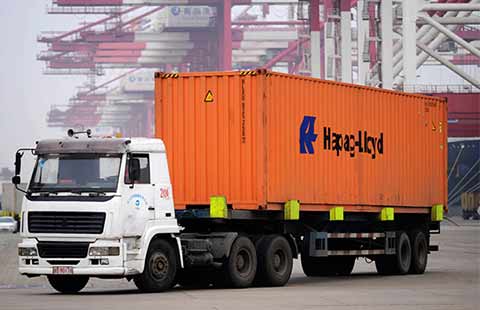China, US, EU differ widely in tackling steel overcapacity
(Xinhua) Updated: 2016-04-21 11:19BRUSSELS - According to statistics of the World Steel Association, world output of crude steel in 2015 was 1.62 billion tons, and average capacity utilization rate 69.7 percent, 3.7 percentage points lower than the 73.4 percent in 2014, which shows that the overcapacity of the world steel sector is increasing.
In view of the significant and growing capacity that exists in the global steel industry, governments of countries with big steel industries are taking immediate action to address the issue.
However, due to the divergence of views on the root of the crisis, endeavors from China, the United States and the European Union (EU) play out differently.
China taking concrete measures, stimulating demand
Addressing a high-level conference in Brussels, China's Assistant Minister at the Ministry of Commerce Zhang Ji said: "It is the slow recovery of the world economy that causes a sluggish demand for steel products, which further leads to the overcapacity issue in the steel sector."
Zhang added that any other analysis or judgment that deviates from this perception will lead to failing to find the proper solutions.
China's output of crude steel in 2015 was 804 million tons, and capacity utilization rate is 71.2 percent, higher than the world average level. China is hence making great efforts to cut excess capacity in the steel sector.
The Chinese government has ceased to license steel projects and started to close outdated plants and eradicate "zombie" companies.
China has so far cut over 90 million tons of obsolete capacity during the 12th Five-Year period. Fixed asset investment in the steel sector has kept declining in the past two years. Fixed asset investment in the ferrous metal smelt and extrusion industry in 2015 dropped by 11 percent year-on-year. Furthermore, market competition and environmental constraints have forced a number of steel mills to exit.
The State Council, China's cabinet, announced earlier this year that crude steel production capacity will be slashed by 100-150 million tons over the next five years. It is estimated that 500,000 laid-off workers will have to be resettled.
"To make sure that excess capacity will be eliminated in an orderly manner, the central government has allocated an earmarked fund of 100 billion yuan ($15.45 billion), which will be used to resettle workers," Zhang said.
"Not a penny of the money will be used for subsidies," he stressed.
Moreover, rather than dumping steel in other countries, the Chinese government has in recent years implemented measures such as export tariffs on some steel products to reduce exports.
"The export tariff for billet is 20 percent and for hot-rolled wire rod 15 percent," he said.
The Chinese government is also committed to vigorously expanding the demand for steel products, Zhang said.
On this front, China has taken a lot of measures such as embarking upon necessary large-scale infrastructure development projects.
"In the future, China will promote the use of steel structures in buildings and greatly increase the proportion of steel structures when rebuilding shanty areas and dilapidated houses and implementing anti-seismic housing projects," he said.
Currently, only 5.6 percent of Chinese buildings use steel structures. China plans to increase that proportion to over 20 percent, which would need an extra 20 million tons of steel products a year.
On the international level, China's Belt and Road Initiative with a vision to strengthen connectivity and infrastructure development of countries along the route will fuel demand for steel, and delivered win-win outcomes through social and economic development, Zhang said.
US, EU efforts: blaming China, using protectionist measures
Besides China, steel-producing countries and regions like the United States and the European Union have also been plagued by overcapacity to different degrees.
However, the EU and United States seem to be focusing their efforts on blaming China and frequently employing trade protectionist measures.
US Secretary of Commerce Penny Pritzker and US Trade Representative Michael Froman jointly issued a statement after the high-level steel meeting in Brussels, accusing China of preventing a global solution.
"Unless China starts to take timely and concrete actions to reduce its excess production and capacity in industries including steel, and works with others to ensure that future government actions do not once again contribute to excess capacity, the fundamental structural problems in the industry will remain and affected governments -- including the United States -- will have no alternatives other than trade action to avoid harm to their domestic industries and workers," their statement warned.
The world's second largest steel producer, the EU, echoed the United States on this perception. Ignoring that the competitive position of the European steel sector has deteriorated significantly in recent years, the EU attributes their difficulties on China and trading practices.
"Excess production of steel in third countries such as China has increased exports, depressed prices, and given rise to an unprecedented wave of, distorting the global level playing field," the EU Trade policy department said after the meeting.
Last month, an European Commission report set out how the European steel sector could overcome its serious challenges, largely due to global overcapacity.
The report, named "Steel: Preserving sustainable jobs and growth in Europe," contained new short-term measures to strengthen the EU's trade remedy measures to restrict steel imports.
The EU is already imposing a record number of trade remedy measures. The bloc has over 100 trade defense measures in place, 37 of them targeting imports of steel products, 16 of which are from China.
On Feb 12 this year, the EU opened three new anti-dumping investigations on steel products originating in China. On the same day, the EU imposed provisional anti-dumping duties on another steel product from China and Russia. Currently, there are ongoing investigations for 10 steel products, six of which concern China.
Chinese steel mainly for domestic use
In reality, Chinese steel products make up a tiny proportion of US and EU steel imports. As a major producer and consumer of steel, China's steel products are mainly for domestic use.
"In recent years, 85-95 percent of steel produced by China have been for domestic consumption. China's annual steel consumption accounts for 45 percent of the global total," Zhang said.
China used to be a net importer of steel before 2005 and is still the fifth-largest importer of steel in the world.
"China imported the equivalent of 13.57 million tons of crude steel in 2015," he said, adding that China has thus contributed to the stable development of the global steel industry.
Experts have said as steel excess capacity has become an acute global challenge, governments and steel-related organizations should take collective action to address the situation.
All steel-producing, consuming and trading economies and raw material supply economies should step up communication and policy coordination and join hands in the endeavor to tackle the challenge of steel overcapacity.
- China becomes top green bond issuer: Moody's
- Chinese vice-premier welcomes US firms to strengthen high-tech exchanges
- On global steel overcapacity, is blaming China really fair?
- Chinese provinces' energy intensity on the decline
- Volkswagen CEO is ready to drive group forward in China
- Farm produce prices continue downward trend
- Chinese dairy giant unveils New Zealand-made infant formula
- Experts say bonds offer way ahead for Hong Kong

















